Engineering advances have improved roller-furling systems, and the latest units show refinements to original design and some promising new innovations. Today, third- and fourth-generation furlers are smoother operating, easier to install, and reliable in their role as long-lived sail-handling systems. The fact that almost every new cruising boat longer than 35 feet comes standard with a roller-furling headsail-and one of the top priorities in an older boat retrofit is the addition of roller furling-shows how well sailors have embraced the sail-handling gear.
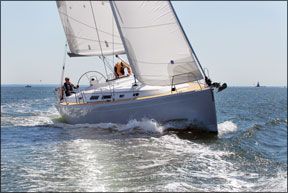
Background
In the late 1970s and early 1980s, Hood, Hyde, and Schaefer were the pioneers behind the idea of handling a headsail with a window-shade-like furling approach. Some of the earliest systems lacked luff-tape foils and relied upon head and tack drum swivels and a faux headstay sewn into the sail luff.
Tension placed on the bearing systems accelerated fatigue, and failures were of a spectacular nature often resulting in a dismasting and marina rumors that caused piston-hanking sails to see a resurgence. Fortunately, engineering improvements stepped in, and Ted Hood and other sailmakers saw the sense in slipping an extruded foil over an existing headstay in order to allow the latter to hold the mast up and the former to handle the furling operation.
What We Tested
The current generation of headsail furlers has seen significant changes over the furlers of yesteryear with respect to engineering and construction materials. To get an idea of whats on the market and see how the newer products fare against the simpler, tried and true furler systems, Practical Sailor rounded up 11 new headsail furlers suited for 30- to 35-foot sailboats.
For reporting purposes, the test group will be divided into two groups: integral and head-swivel systems. However, in testing, we compared all products.
Four of the 11 systems evaluated are integral systems that have no upper halyard swivel. These units attach the head of the jib to a built-in halyard or a fitting at the top foil section. Three of these four completely eliminate the use of ball and roller bearings, relying on simpler bushings to offset thrust and axial loads.
The integral systems we tested were the Alado A-2, Cruising Design Inc.s Flexible Furler, Reefurl, and Spin-Tecs Triumph 2000. Look for performance test results and the full report on these furlers in the September issue.
This issue, we focus on head-swivel furlers from Furlex (Seldn Mast), Harken Inc., Schaefer Marine, Facnor, and US Spars. The seven head-swivel products, ranging in cost from $950 to $3,200, that we tested were the Facnor LX 130, Harken MkIV and Cruising 1, Profurl LCI32, Schaefer 2100, Furlex 200S, and US Spars (Z-Spar) Z-780.
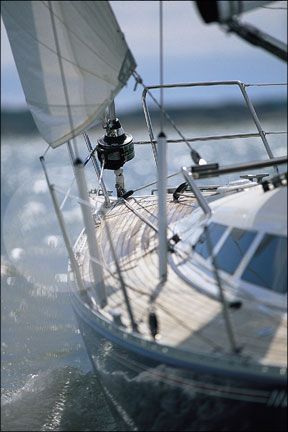
Photos by Ralph Naranjo (above) and courtesy of Seldén Mast (below)
One swivel-furler maker not represented in our test was Reckmann Reefing Systems (www.reckmann.com), whose products are distributed in the U.S. by Euro Marine Trading. Reckmanns RS2000 furler is designed for boats 30 to 90 feet. It and Reckmanns other furling systems are very well designed and well built, but their high costs (upward of $8,000) priced them out of this test field. Reckmann furlers are better suited to yachts over 50 feet, in our opinion.
How We Tested
Practical Sailor
Hardware design is important but equally so is the installation of the unit on board. As many riggers put it, “the best way to insure operational reliability is to follow the manufacturers guidelines implicitly.” And so we looked closely at how each system had been set up aboard the test boats, and we were amazed at how often poor geometry in furling line leads, excessively loose standing rigging, and over-tightened halyards took a toll on furler efficiency.
Testers also inspected a disassembled version of each system, giving close scrutiny to system design and component manufacture. We considered how furling loads migrate from the line to the drum and into the foil itself. Part of the big picture included bearing systems and linkage designs. It was clear that most manufacturers were tuned in to corrosion abatement, picking the right metal for the job, and coming up with foil interlocks that better held the sections together.
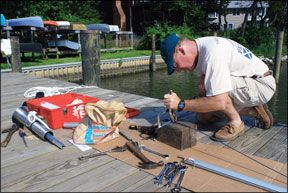
A look at a riggers scrap heap revealed dead furlers with corroded, frozen bearings, foils that would not stay together when hoisted, and first-generation composite bearings suffering from UV degradation. We also talked to furler owners, listening to stories of halyard wraps, rotating drum guards, and twisted (barber-poled) foils.
So, primed with first-hand underway experience and a good deal of background data, we dug deep to see how each unit turned a pull from a sailor into a twist of the sail.
What We Found
After sailing and tugging on the reefing lines, we found all of the units to be operationally reliable in normal 5- to 20-knot conditions. Not surprisingly, the units fitted with a plethora of ball bearings spun more freely, even under load, and the super slick title was a three-way tie among the Furlex 200S, Harkens MkIV, and Schaefers 2100, the former spinning on stainless bearings and the latter two packed with multiple large-
diameter Torlon and Delrin bearings.
From a sail shape and reefing point of view, we found that units with an articulating tack (Facnor, Furlex, and Harken MkIV) aided reefing by coaxing sails to set a little flatter. However, the most influential hand in the reefing process remains the skill of the sailmaker.
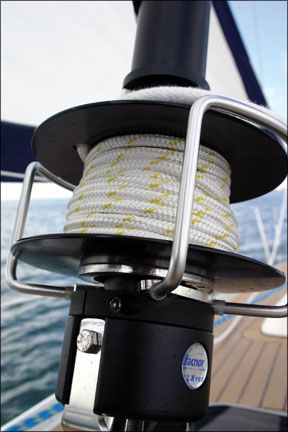
Photo courtesy of Facnor
Facnor LX130
This headsail furler is a favorite among Europeans, and like other Facnor products, it has been sea-trialed in grueling offshore racing conditions.
The system is well engineered and blends a high torque-carrying, rounded foil shape with nicely machined connecting links. The unit uses a traditional swivel and mast-halyard hoist design, and its telescoping foil section eliminates the need to cut a “shortened section.”
During installation, neither the wire nor the turnbuckle have to be replaced, and the 40-mil hard anodized parts are quite corrosion resistant.
The bearing system is referred to as the “bearing box,” and it contains a stainless-steel thrust bearing and large fiber/polymer bearings for axial loads all housed in the compact drum hub. Theres a handy anti-halyard wrap deflector and optional turnbuckle kit.
Bottom line: This unit has gained attention of builders and do-it-yourselfers alike. One minor issue testers noted was that the articulating tack bearings are exposed to continuous UV degradation.
Furlex 200S
Furlex, manufactured by Seldn Mast, has been a frontrunner in headsail furling for decades. Among all the units we looked at, the 200S was the only one that came with a new headstay wire complete with turnbuckle, toggle, and the recommended Sta-Loc compression fitting. Covering a questionable headstay with a new furler can lead to problems. Furlex prevents such complication by offering the total
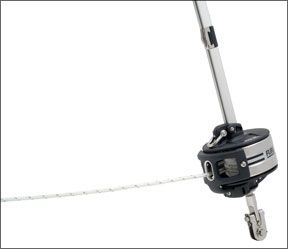
package.
In addition to a well-designed and packaged array of parts, the Furlex comes with a superbly illustrated manual (in four languages-no need to learn new words while trying to put together this furling system).
At the heart of Furlexs twist technology is an investment-cast stainless drum core and bearing support for multiple races of stainless bearings. The system handles thrust and axial loads very efficiently. The patented halyard swivel “load distributor” spreads the load over many balls to reduce point loading and friction.
The foil sections are double slotted and elliptical in shape, and the full-turn tack swivel allows the mid portion of the sail to lead off in the furling/reefing process, reducing excess draft in roller-reefed sails.
Bottom line: Among a field of quality products, Furlex stands out for its investment cast stainless hub and bearings.
Harken MkIV
Harken has two new furling systems on the market, and both eliminate the “built in” turnbuckle that Harken had used for decades. The new Mark IV system incorporates the twin slot foil of its proven predecessor the Mark III. The unit retains the full rotation tack and head swivels that cause the furling and reefing operation to flatten the mid portion of the headsail first-a feature that many sailmakers prefer.
The big change for Harken is going to a two-tiered approach and offering different units to cruisers and racers with the Mark IV being the racing/performance cruising option. On both systems, thrust and axial loads are handled by a combination of Delrin and Torlon bearings nicely tucked away in the drum and hidden from sunlight. The interlocking foil segments are secured with captured links that are held in place with adhesive and mechanical fasteners.
Bottom line: We found the Mark IV is a compact and efficient furler. It gets the PS Recommendation as its certainly destined to be a favorite among more performance-oriented sailors.
Harken Cruising 1
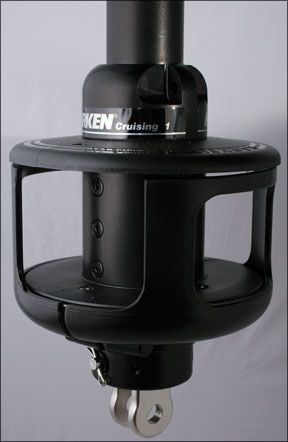
Photos by Ralph Naranjo
The Harken Cruising Unit No. 1 utilizes a rounded foil section with a single track. It likely will handle more furling and reefing torque than the foil used on the Mark IV system.
Flat-head screws and Loctite work in conjunction with Easy C-shaped connectors and bushings to install the head foil over an existing headstay and turnbuckle. The tack of the cruising furler is fixed to the drum, eliminating the flattening feature that many came to appreciate in earlier Harken gear.
Another change is the greater play in the drum toggle, which helps the system cope with the increased headstay sag often found aboard cruising boats. The furling action is smooth and easy, and the familiar Harken bearing swirl accompanies the low-drag furling.
Bottom line: The single-groove foil limits some headsail options.
Profurl LCI32
Profurl, a key player in the field of roller furling, continues its engineering evolution, making a solid performer even better with a series of “from the drum to the top swivel” tweaks and changes. The LCI32s round foil tubes use a C-shaped connector spline and heavy-duty, threaded fasteners that are anodized to reduce corrosion.
A stainless-steel luff feeder snaps into place on the appropriate foil segment with a click. One of the big pluses for this system is the variation it offers in drum clearance and swivel positioning, a feature that has gained rigger approval for decades.
The system places no torque loads on set screws, and seems to have overcome issues such as halyard wraps and foil segment separation that plagued earlier equipment.
Profurl uses a hardened carbon-steel ball bearing set packed in grease and protected by a double-lip seal. The company says that it “can’t corrode because the bearings are sealed in grease.” However, seals can fail, and those with older systems should do a careful bearing check.
Bottom line: The bearing system was the units only feature that gave testers pause.
Schaefer 2100
The latest Schaefer headsail furler is a display of well-executed stainless-steel castings, machined parts, and welded and extruded components. The 2100s Torlon bearings make furling silky smooth. Helicoils have been inserted to lessen corrosion caused by stainless-steel fasteners.
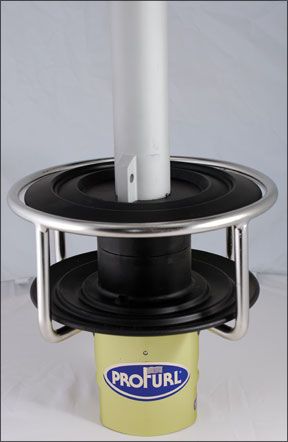
With the 2100, Schaefer did not walk the razors edge separating performance and longevity. The heavy-duty foil section is rounded with high-torque carrying links transferring loads from one to the next. The drum and swivel are large enough to pack good-sized bearing races and transfer plenty of torque to the foil section. Foils are connected via stainless pop rivets that can be drilled out to disassemble-no worries about corroded fasteners.
The installation kit comes with furling line lead blocks and a toggle and link for those who want extra deck clearance for anchor handling.
Two minor drawbacks testers noted were that Torlon bearings could be seen in a few places, which means sunlight can also see the Torlon, and the top swivel has some exposure to sunlight. Schaefer noted that Torlon has a high tolerance to UV, and reported that in 20-plus years of using Torlon in their furlers, the company knows of no failure due to UV damage.
Bottom line: The swivel and bearings possible exposure to sun is a minor issues in an otherwise very well-engineered, yet pricey, system.
Z-Furl Z-780
US Spars, a subsidiary of Frances Z-Spar, recently released a new Z-Furl unit that incorporates a seamless head foil and stainless-steel bearings. The Z-780s double luff elliptical foil system incorporates a conventional top swivel thats engaged by a mast halyard.
The 2.3-inch inner drum diameter is on the small side, but with a full-length plastic headstay bushing and efficient bearings in the drum and swivel, it remains an easy system to operate.
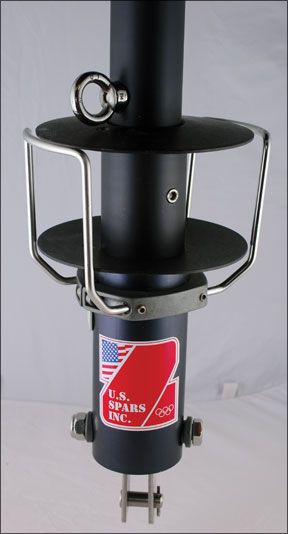
Photos by Ralph Naranjo
One of the most interesting features offered by US Spars is the chance to acquire this system in a one piece, no foil-segment junction set up. Because of shipping limitations, this is usually only offered for new boats or new spars, but other arrangements for shipping may be able to be arranged.
Bottom line: The narrow overall diameter of the drum makes it a good selection for those boats with limited foredeck space or where pulpit intrusion may be an issue. And its below $1,000 price makes it our Budget Buy.
Conclusion
Each boat owner must decide whether they prefer a system that allows them to wash off plastic bearings with a hose, rely on permanently sealed high carbon-steel bearings, care for open race stainless-steel bearings that occasionally need cleaning and lubrication, or no ball bearings at all. Price is always a consideration, and in this furler round up there was an astounding 400-percent difference in price between the least and most expensive units (including the integral systems to be reviewed next month).
Among the head-swivel furlers, picking a winner was difficult due to the refinements most of these products have gone through and an obvious across-the-board increase in quality. But in the end, sound engineering and the reliability of an investment cast stainless hub assembly and bearings gave the extra nudge to Furlex. Harkens MkIV hits a price point and is recommended for performance-minded sailors.
To find out which integral system topped testers charts and to see how those furlers stack up against the head-swivel lot evaluated this month, stay tuned for part two of this report coming up in the September issueconducted on-the-water performance tests of each system on various boats in 5- to 20-knot wind conditions. Testers considered how easily each system furled and unfurled the sail and how smooth the process was. They also evaluated sail shape and how easy it was to reef in a blow.


































Thanks for sharing this interesting blog with us.My pleasure to being here on your blog.